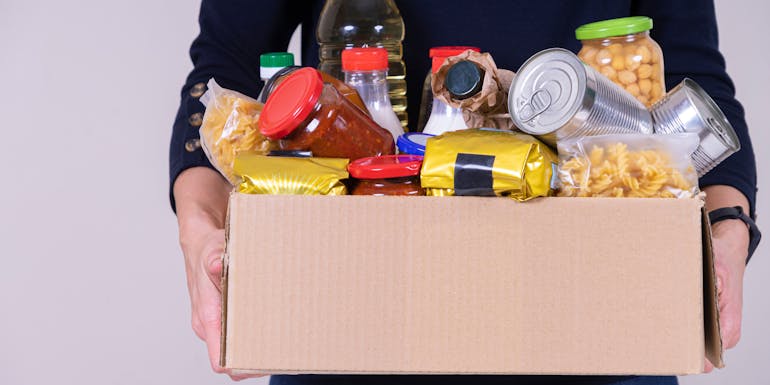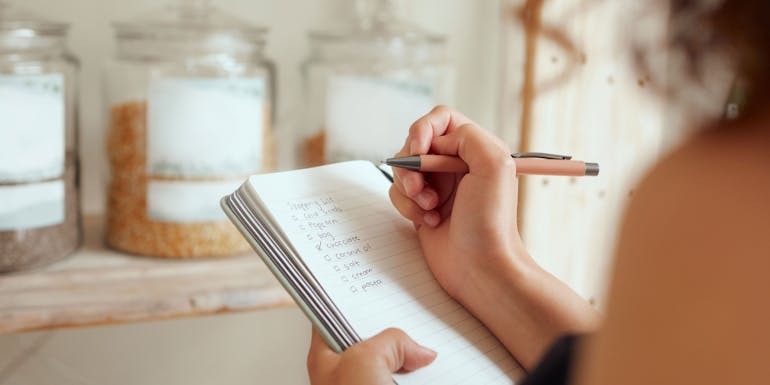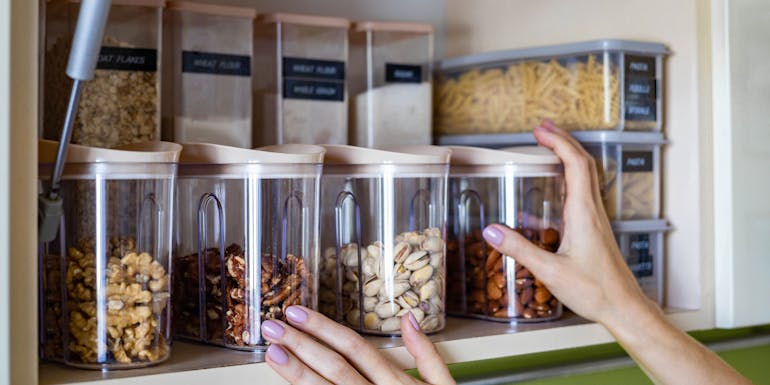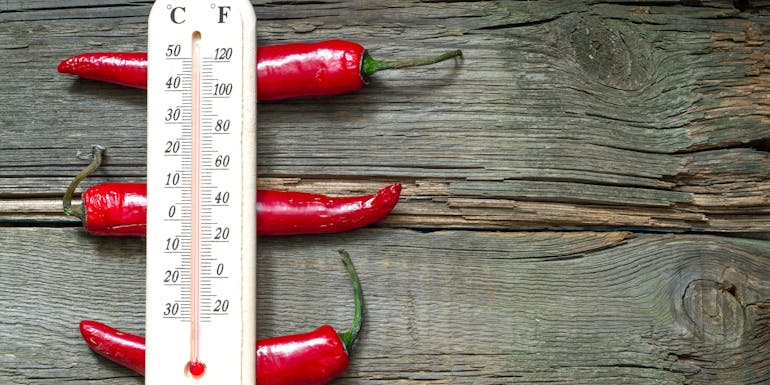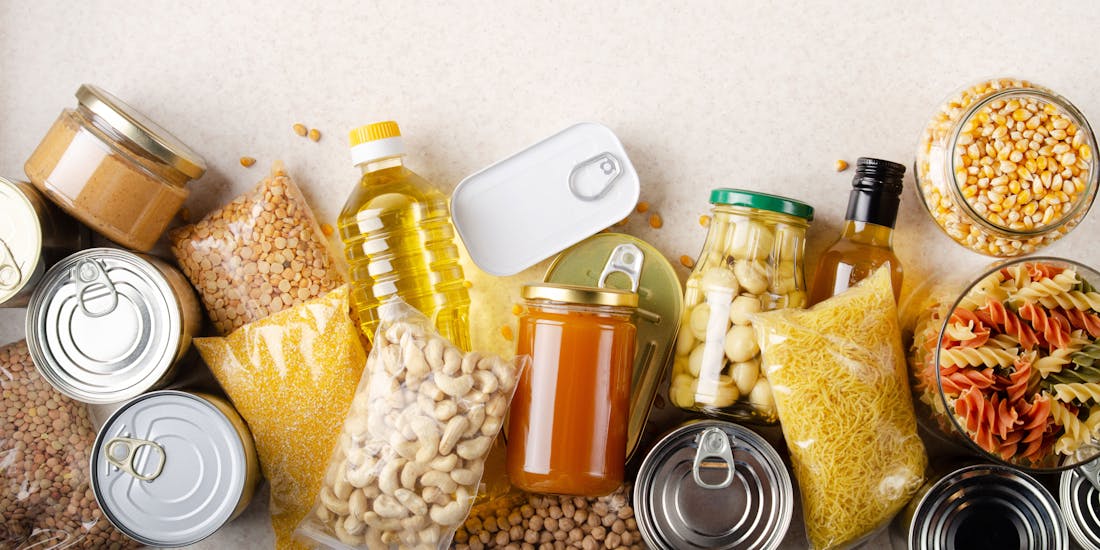
Nadine Walder, 4 April 2023
Kitchen
Tips for storing food correctly
Well-thought-out food storage makes sense for many reasons. In order to ensure shelf life and quality, food must be stored correctly and there are many factors* which play a role in this. In this article, I will give you lots of tips on storage and how to store your food correctly in order to ensure a long shelf life and consistent quality.
* The factors referred to in this article relate to the storage of food that does not need to be put in the refrigerator, so not fresh products such as soft cheese, spreads, meat, fish or vegan alternatives to meat.
Reasons for and benefits of stockpiling food
Over the past few years, you will certainly have thought about whether or not you should be stockpiling food at home. The coronavirus pandemic and supply shortages due to the war in the Ukraine have made this topic more relevant than ever. The most obvious reason why you should stockpile food at home is, of course, to be prepared for unforeseeable events such as natural disasters, power cuts and pandemics.
In its brochure entitled «Smart advice – Stockpiling», the Federal Office for National Economic Supply (BWL) recommends keeping an emergency stockpile of storable foodstuffs that is enough for about a week, as well as 9 litres of water* per person. According to the BWL, the foodstuffs that you stockpile should be based on your own eating habits. The following foodstuffs are generally suitable for stockpiling:
- Fresh produce: potatoes, onions, garlic, apples, etc.
- Dry goods: pasta, rice, pulses, flour, sugar, salt, oatmeal, muesli, bread, cornflakes, etc.
- Canned goods: vegetables (peas, sweetcorn, beans, carrots), meat (beef, chicken, pork), soups, ready meals, etc.
- Dairy products: UHT milk, condensed milk, yoghurt, cheese, etc.
- Snacks: nuts, dried fruit, chocolate, etc.
- Beverages: water, fruit juices, tea, coffee, etc.
Besides this obvious reason for stockpiling food, there are other benefits. Buying in bulk and stockpiling can save you money: you can take advantage of special offers and discounts as many retailers offer bulk discounts. You can also save time – if you always have something in the house, you won’t have to go shopping as often and you will always have a range of ingredients to hand. This also means that you will have more options open to you when it comes to cooking and preparing meals.
Once you have made the decision to create a stockpile, the next step is to draw up a plan. But what do you need to keep in mind? Read on to find out.
* Although we have almost unlimited quantities of drinking water in Switzerland, the BWL underlines the importance of storing a supply of water. We can survive longer without food than we can without water. It is important to have a supply of water in case a pipe bursts or drinking water becomes contaminated, for example.
Stockpile food but do it correctly!
By planning your stockpiling carefully and thoughtfully, not only will you be well-prepared for emergency situations but you will also be able to get the most out of the benefits mentioned. These are the factors that you should take into account when planning:
- Type and quantity of food to store: Think in advance about what foodstuffs you would like to stockpile and what quantity you need. Write a list and only buy what you and your nearest and dearest need. That way you will save time and avoid unnecessary spending on food.
- Check your store regularly: Check your store regularly and pay attention to expiry dates. Use the oldest food first to ensure that nothing spoils.
- Rotate food stored: When you buy more food to store, make sure that you use the older food first. Follow the FIFO principle (first in, first out) – rotate food by bringing the oldest food to the front.
- Documentation: It is advisable to keep a list of your stored food and put it somewhere where it is easily accessible: this will be helpful in a stressful emergency situation in particular.
A major aspect when stockpiling is food storage and there are a number of factors to consider with regard to this.
Storing food: how it’s done
Storing food correctly is of decisive importance for shelf life and quality. To ensure that food is protected and does not spoil, the following factors should be taken into account:
- Storage location: Most foodstuffs that are suitable for storage should be kept in a dry, cool, dark place in order to ensure shelf life and quality. They should be stored away from heat sources such as radiators and sunlight as this will cause them to spoil quicker.
- Hygiene and cleanliness: The place where you store food should be clean and hygienic in order to prevent the contamination and spoilage of food. Shelves and containers should be cleaned regularly. Regular cleaning is necessary in order to prevent the build-up of dust and dirt and the formation of mould.
- Packaging: The type of packaging is decisive for food storage. A lot of foods should be kept in airtight containers in order to ensure shelf life and quality. However, other foods such as fruit and vegetables should not be kept in airtight packaging as this could cause them to spoil quicker.
In addition to these factors, temperature and humidity play a very important role in the storage of food. There are a number of important points to take into account with regard to this.
The correct temperature and humidity for food storage
The ideal temperature and humidity for food storage primarily depends on the type of food. Usually, in the case of packaged food you will find information on the correct storage temperature and humidity on the packaging. Usual instructions include:
- Frozen product: For storage in freezer compartment at min. - 18 °C only.
- Keep refrigerated: Storage in the refrigerator at temperatures between 0 and 8 °C.
- Store in a cool place: Storage in a cool place, not in the refrigerator, at temperatures up to max. 18 °C
- Store at room temperature: Storage at temperatures between 18 and 22 °C
- Protect from heat: Goods can withstand temperatures which are higher than room temperature but should never be stored next to a heat source.
- Store in a dry place: Goods must be stored in a dry place with maximum 70% relative humidity.
- Store away from light: Goods must be protected from direct light.
A temperature below 20 °C is generally ideal for most foodstuffs that are suitable for stockpiling. The humidity should be between 50% and 60% in order to reduce the growth of mould and bacteria. Foodstuffs such as onions, garlic and potatoes, for example, can be stored in a dry place at room temperature. If possible, canned goods should be stored below 20 °C and in a dry place. Foodstuffs such as flour, sugar and rice should be stored in airtight containers.
When you buy food to store, you are recommended to read and follow the storage instructions on the packaging. It would go beyond the scope of this article to list the right temperature and humidity for every type of food.
If you do not want to store your food in the kitchen for reasons of space, it is recommended to store it in a pantry or even in the basement.
Additional tip: create ideal conditions in your pantry
As already explained in the previous section, the ideal temperature and humidity and temperature in a pantry naturally also depends on the food being stored. Generally, a temperature between 12 °C and a maximum of 20 °C and a level of humidity between 50% and 60% are suitable for storing most foodstuffs. To achieve these conditions, you can try the following steps:
- Choose a suitable place if possible: Make sure that the place where you want your pantry to be is dry, cool and away from light. A garage or a basement can be a good choice, for example.
- Shelves and containers: They can also help ensure effective storage. Use shelves to guarantee good air circulation and ensure that all foodstuffs are accessible. You should also avoid storing food directly on the floor.
- Air-conditioning: Air-conditioning in the pantry can also help achieve the correct temperature. However, costs and energy consumption should be taken into account.
- Do not open doors too often: Avoid opening pantry doors too often. That is the only way to ensure that temperature and humidity remain constant. You should also avoid leaving the door open for long periods of time.
- Store food based on temperature required: A simple way of achieving the correct temperature and humidity is to store foodstuffs according to their temperature and humidity requirements. Store food requiring a cooler temperature such as oils and nuts, for example, in the cooler parts of the pantry.
- Use dehumidifiers: A dehumidifier is a very efficient solution for reducing the humidity in a room.
- Thermometers and hygrometers: Thermometers and hygrometers are useful tools for monitoring the temperature and humidity in your pantry. With these measuring devices, you can make sure that you have optimal storage conditions for your food.
You now have all the tips and tricks you need for well-thought-out, useful stockpiling. Do you still need a hygrometer or dehumidifier? With our hygrometer ladies Selina and Selina little, you can monitor the level of humidity closely. They will show you whether or not the level of humidity is ideal using smileys. And our dehumidifiers TheoTheo and AlbertAlbert will remove humidity efficiently. They have a hygrostat and switch on automatically if the level of humidity is too high. As soon as the ideal humidity is reached, they switch off again automatically. Both dehumidifiers also have a drainage hose that can be connected directly to the outlet, thus eliminating the need for regular emptying.
If you have questions related to indoor room climate, please get in touch with us. Or subscribe to our newsletter to regularly get informed about current topics regarding indoor climate, experience reports or Stadler Form insights.
